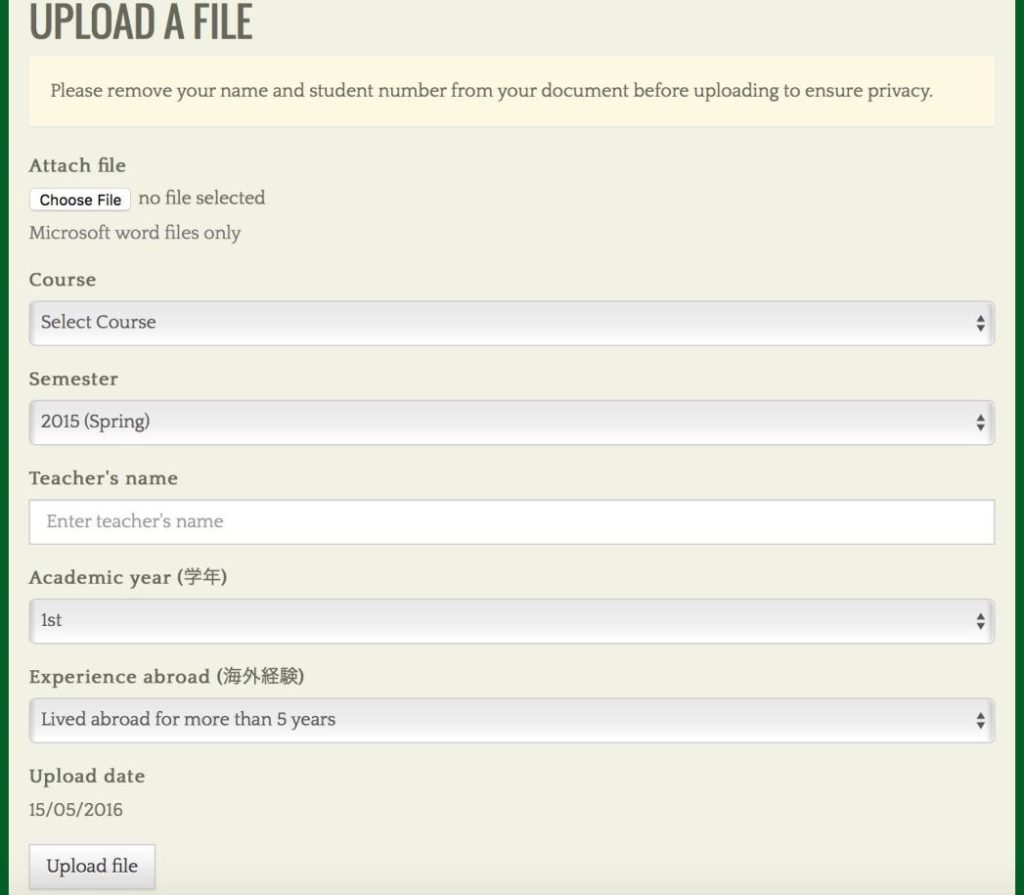Since the spring semester of 2016, all students in IE Writing (all three levels) and Academic Writing have been required to upload the final draft of their written assignments to the new “Database of Student Writing.” In this way, we are rapidly building up a collection of student writing as a deterrent against plagiarism.
The way it works is that…
1) Students upload their papers to a particular website after logging onto it.
2) After the paper has been successfully uploaded, a unique “reference number” is generated that students must print out and give to their teacher.
3) With that “reference number,” the teacher is able to download the paper (although that’s not required as students should submit hard copies of their paper as well) and, at the same time, confirm that it was not plagiarized, either in part or entirely. The teacher will only need to check the database in the event that (s)he is suspicious that a student’s work has been plagiarized.]
How students use the database for submitting written work
Students begin by going to this web page: http://www.ap.agu4u.org/users/login. (See Fig. 1).
The student will log in as follows:
Username : student
Password : [Students will have this in their IE Core and Writing Books; teachers may ask Joseph Dias for it.]


After logging in, the student will see the “upload a file” page (see Fig.2). They should make all the appropriate selections and input what they are prompted to input

They should first click the “choose file” button, search for the file (their essay in Microsoft Word format) on their computer, and select it (see Fig.3). If this operation is successful, next to the “choose file” button (where it previously said “no file selected”) they should see the name of the uploaded file.

Next, they should click the “upload file” button and, upon successfully uploading the file, a page will appear with the phrase “UPLOAD SUCCESSFUL (see Fig. 4). On that same page, a unique reference number will be provided along with the time and date of submission. Students must print out the “UPLOAD SUCCESSFUL” screen, which includes their file’s unique reference number (see Fig. 4 again) and present it to their teacher along with a hard copy of that written work. Students must not be given credit for an assignment if they have not shown evidence that they uploaded it to the “Database of Student Writing.” That evidence will be a print out of the “UPLOAD SUCCESSFUL” screen.
How teachers will use the database/plagiarism detection system
The MS Word files of the students’ submitted written work (see Fig. 5) can be accessed by teachers at: http://www.ap.agu4u.org/users/login (see Fig 5.1)


Teachers should login as follows:
Username : admin
Password : [THIS IS SECRET –ASK DIAS FOR IT ]
Teachers wishing to access the electronic files of their students’ work should ask the IE Program coordinators for the administration password. Finally, when a teacher does detect clear and indisputable evidence of plagiarism in student writing, (s)he is asked to report it to the IE Program coordinators at this report page: http://tinyurl.com/mum2goq.

Teachers will be able to search for strings of words that a particular student’s work might share with other entries in the database. The system will also facilitate Internet searches for particular phrases used in a student’s writing which are deemed suspicious by the teacher.
When the students submit the print out of the “reference number” corresponding to their uploaded work, be sure that they include their name with the printed reference number. That way, the teacher will be able to match a student to a particular submitted file (essay). This is important as students are asked to strip the electronic versions of their papers of any personal information in order to maintain their privacy. English Dept Teachers Handbook. In other words, individual teachers will be the only parties able to match uploaded files to particular students due to the privacy safeguards built in to the system.
At this point in its development, the database is mainly intended as a deterrent to plagiarism rather than as a highly effective tool for detecting it. But, we should be able to detect particularly egregious cases of plagiarism of work previously submitted to the database by classmates, or even work submitted by the same student for different classes. The system will also facilitate Internet searches of strings of words/ phrases judged to be suspicious by the teacher as the search terms put in the search field of the database will automatically be fed into the search field of an Internet search engine.
It remains important for teachers to follow their intuitions and question students when their written work seems beyond their capacity or inconsistent with previously submitted samples. The database search tools will not catch all cases of plagiarism and may generate “false positives” when appropriately quoted passages are flagged as possibly being plagiarized.
